Incorporating movement into the workday is essential for enhancing productivity, health, and energy levels. Simple strategies such as standing desks, walking meetings, and stretching breaks can help employees stay engaged and focused, ultimately leading to improved performance and well-being.
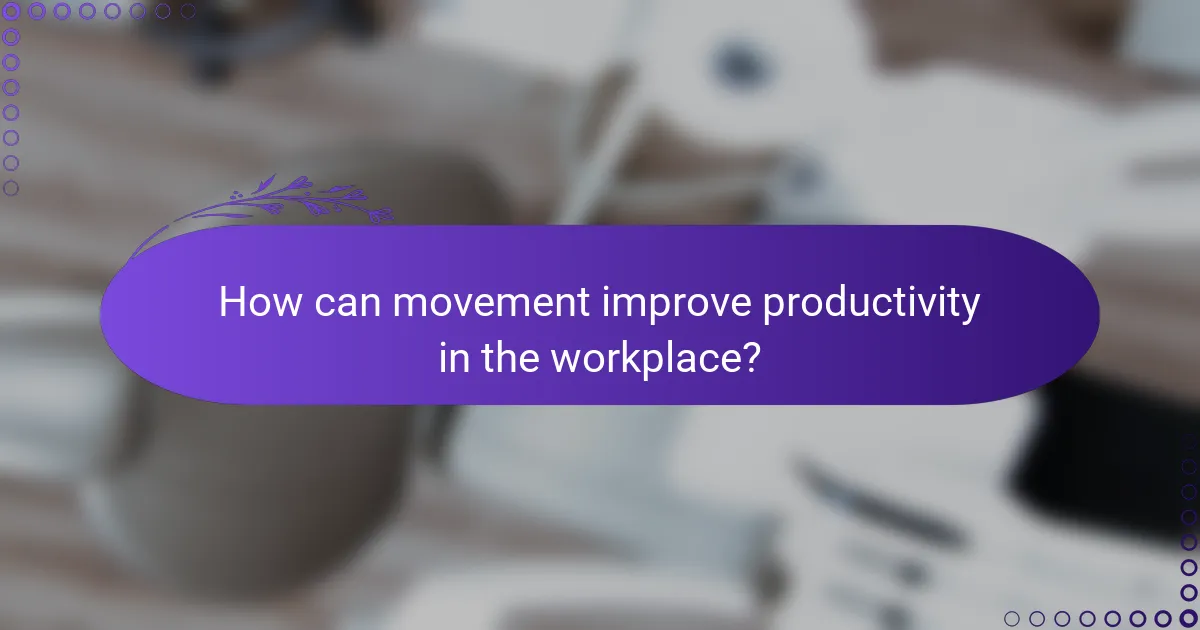
How can movement improve productivity in the workplace?
Movement can significantly enhance productivity in the workplace by boosting energy levels and improving overall well-being. Incorporating physical activity into the workday helps employees stay engaged and focused, leading to better performance and efficiency.
Increased focus and concentration
Regular movement, such as short walks or stretching, can enhance focus and concentration among employees. Physical activity increases blood flow to the brain, which can sharpen cognitive functions and help maintain attention on tasks.
To maximize focus, consider implementing brief movement breaks every hour. These breaks can last just a few minutes but can lead to improved mental clarity and reduced fatigue.
Enhanced creativity and problem-solving
Movement can stimulate creativity and enhance problem-solving skills. Engaging in physical activity often allows the mind to wander, leading to new ideas and innovative solutions to challenges.
Encourage employees to take walking meetings or brainstorm sessions outside. This change of environment can foster creative thinking and collaboration, resulting in more effective outcomes.
Boosted employee morale
Incorporating movement into the workday can significantly boost employee morale. Physical activity releases endorphins, which can improve mood and create a more positive workplace atmosphere.
Consider organizing group activities, such as team sports or fitness challenges, to promote camaraderie and a sense of belonging. These initiatives can lead to higher job satisfaction and lower turnover rates.
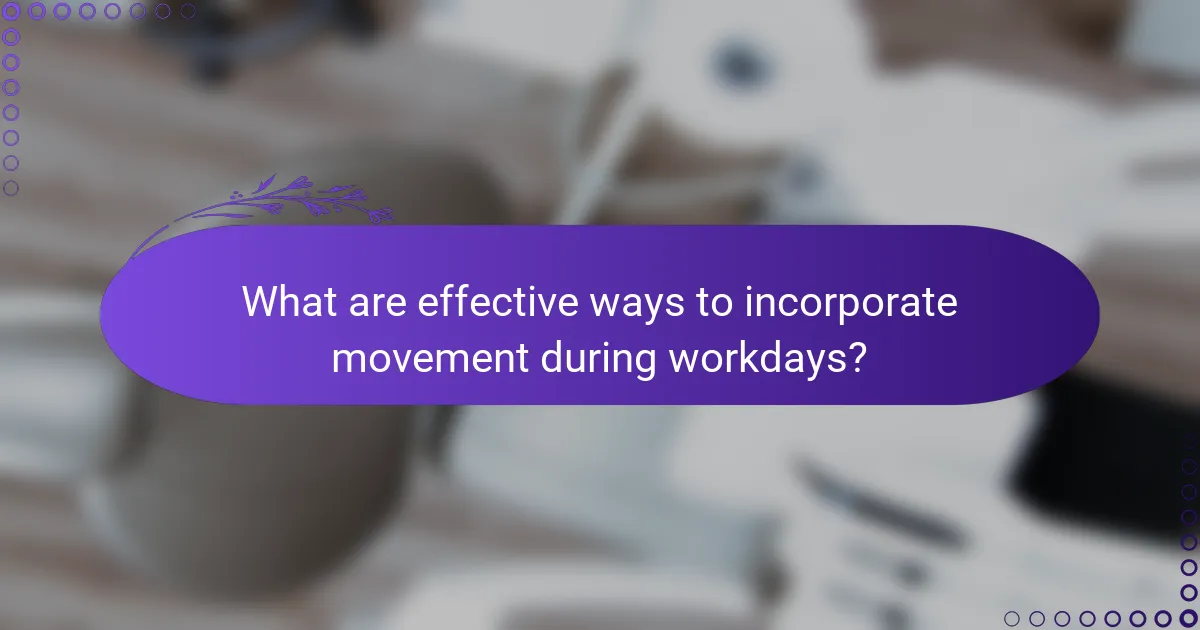
What are effective ways to incorporate movement during workdays?
Incorporating movement during workdays can significantly enhance productivity, health, and energy levels. Effective strategies include using standing desks, engaging in walking meetings, taking stretching breaks, and offering on-site fitness classes.
Standing desks and walking meetings
Standing desks allow employees to alternate between sitting and standing, which can reduce fatigue and improve focus. Consider setting up adjustable desks that accommodate various heights for optimal ergonomics.
Walking meetings are another effective way to incorporate movement. These meetings can be held outdoors or in spacious indoor areas, promoting creativity and engagement while allowing participants to stay active. Aim for short meetings of 20-30 minutes to maintain energy levels.
Stretching and mobility breaks
Regular stretching and mobility breaks are essential for reducing muscle tension and improving circulation. Encourage employees to take short breaks every hour to stand up, stretch, and move around for a few minutes.
Implementing a simple routine of stretches targeting the neck, shoulders, and back can be beneficial. Providing visual guides or reminders can help employees remember to take these breaks and maintain their physical well-being throughout the day.
On-site fitness classes
Offering on-site fitness classes can motivate employees to stay active during work hours. Classes such as yoga, Pilates, or high-intensity interval training (HIIT) can cater to various fitness levels and preferences.
Consider scheduling these classes during lunch breaks or after work to maximize participation. Providing incentives, like discounts on gym memberships or wellness programs, can further encourage employees to engage in physical activities and improve their overall health.

How does movement impact health in office environments?
Movement significantly enhances health in office settings by reducing sedentary behavior, which is linked to various health issues. Incorporating physical activity into the workday can lead to improved overall well-being and productivity.
Reduced risk of chronic diseases
Regular movement in office environments can lower the risk of chronic diseases such as obesity, diabetes, and certain cancers. Engaging in physical activity for even short periods throughout the day can help mitigate the effects of prolonged sitting.
To effectively reduce these risks, aim for at least 150 minutes of moderate aerobic activity each week, which can be broken down into manageable sessions. Simple changes like taking the stairs or walking during breaks can make a significant difference.
Improved cardiovascular health
Incorporating movement into your workday promotes better cardiovascular health by improving blood circulation and lowering blood pressure. Activities like standing or walking meetings can contribute positively to heart health.
To enhance cardiovascular benefits, consider standing for 15-30 minutes every hour or taking short walks during breaks. These small adjustments can lead to noticeable improvements in heart function over time.
Better mental health outcomes
Movement in office environments is linked to improved mental health, reducing symptoms of anxiety and depression. Physical activity releases endorphins, which can enhance mood and overall mental well-being.
Incorporating brief exercise sessions, such as stretching or quick walks, can help clear the mind and boost focus. Aim for at least a few minutes of movement every hour to maintain mental clarity and reduce stress levels throughout the workday.
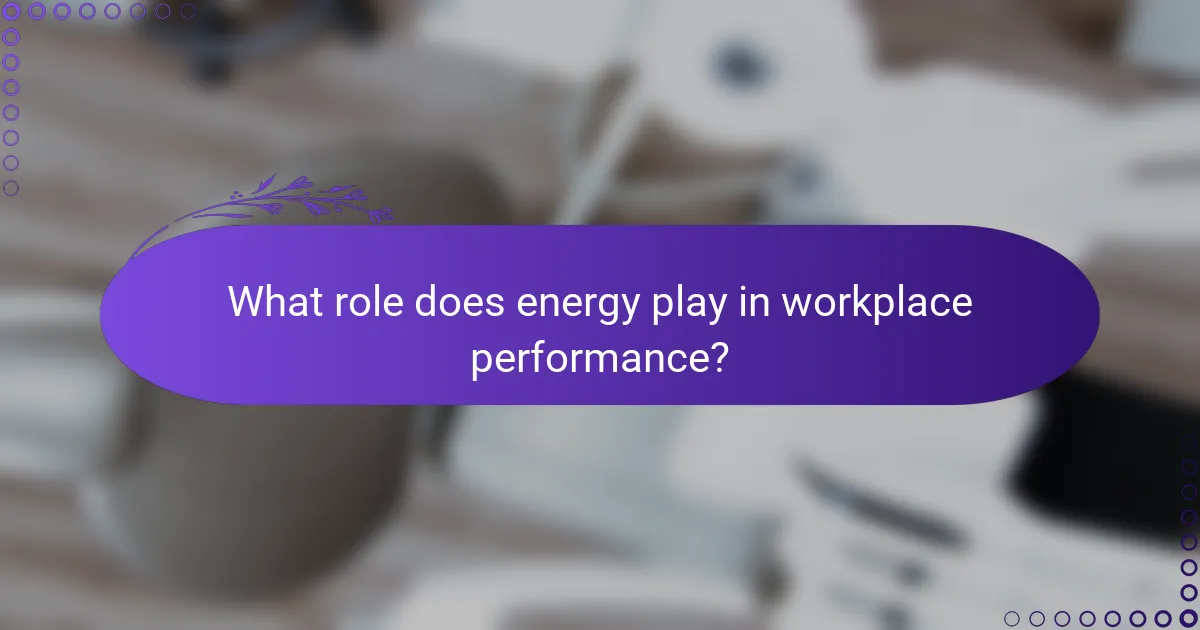
What role does energy play in workplace performance?
Energy significantly influences workplace performance by affecting focus, motivation, and overall productivity. Higher energy levels can lead to improved efficiency and better decision-making, while low energy can hinder performance and creativity.
Increased energy levels from physical activity
Engaging in regular physical activity boosts energy levels by enhancing blood circulation and oxygen flow to the brain. Simple actions like taking short walks or stretching during breaks can invigorate employees and reduce fatigue. Aim for at least 30 minutes of moderate exercise most days to maintain optimal energy levels.
Connection between energy and productivity
There is a strong link between energy and productivity; energized employees tend to complete tasks more efficiently and with greater accuracy. Studies suggest that short bursts of physical activity can lead to a 15-20% increase in productivity. Implementing standing desks or encouraging movement breaks can help sustain high energy throughout the workday.
Impact of energy on team dynamics
High energy levels can positively affect team dynamics by fostering collaboration and enhancing communication. Teams with energized members often exhibit higher morale and creativity, leading to innovative solutions. Conversely, low energy can create a lethargic atmosphere, reducing engagement and teamwork. Encouraging group activities or team challenges can help maintain a vibrant energy within teams.
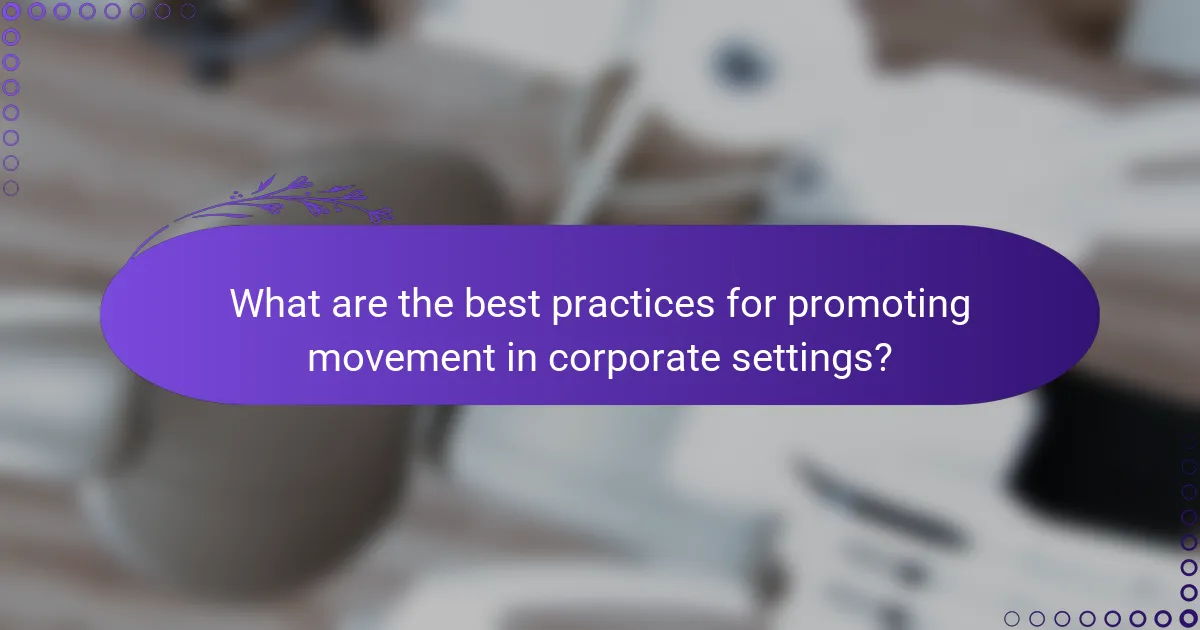
What are the best practices for promoting movement in corporate settings?
Promoting movement in corporate environments involves creating an atmosphere that encourages physical activity throughout the workday. Implementing practical strategies can enhance employee productivity, health, and overall energy levels.
Creating a movement-friendly culture
Establishing a movement-friendly culture requires integrating physical activity into daily routines. Encourage walking meetings, standing desks, and break times dedicated to stretching or light exercise. This approach fosters an environment where movement is normalized and valued.
Leadership plays a crucial role in this cultural shift. When managers model active behaviors, employees are more likely to follow suit. Regular communication about the benefits of movement can reinforce this culture and motivate staff to engage in physical activity.
Implementing wellness programs
Wellness programs can significantly enhance movement in the workplace by offering structured activities and resources. Consider initiatives like group fitness classes, yoga sessions, or organized sports teams that promote regular participation. These programs can be tailored to fit various fitness levels and preferences.
Incorporating challenges, such as step competitions or fitness tracking, can also boost engagement. Providing incentives for participation, such as discounts on health insurance or wellness-related rewards, can further motivate employees to take part in these programs.
Incentivizing physical activity
Incentivizing physical activity can effectively encourage employees to move more during their workdays. Offering rewards for achieving fitness goals or participating in wellness activities can create a positive feedback loop. Examples include gift cards, extra time off, or recognition in company communications.
Consider implementing a points system where employees earn points for various activities, which can be redeemed for prizes. This approach not only promotes movement but also fosters a sense of community and friendly competition among colleagues.
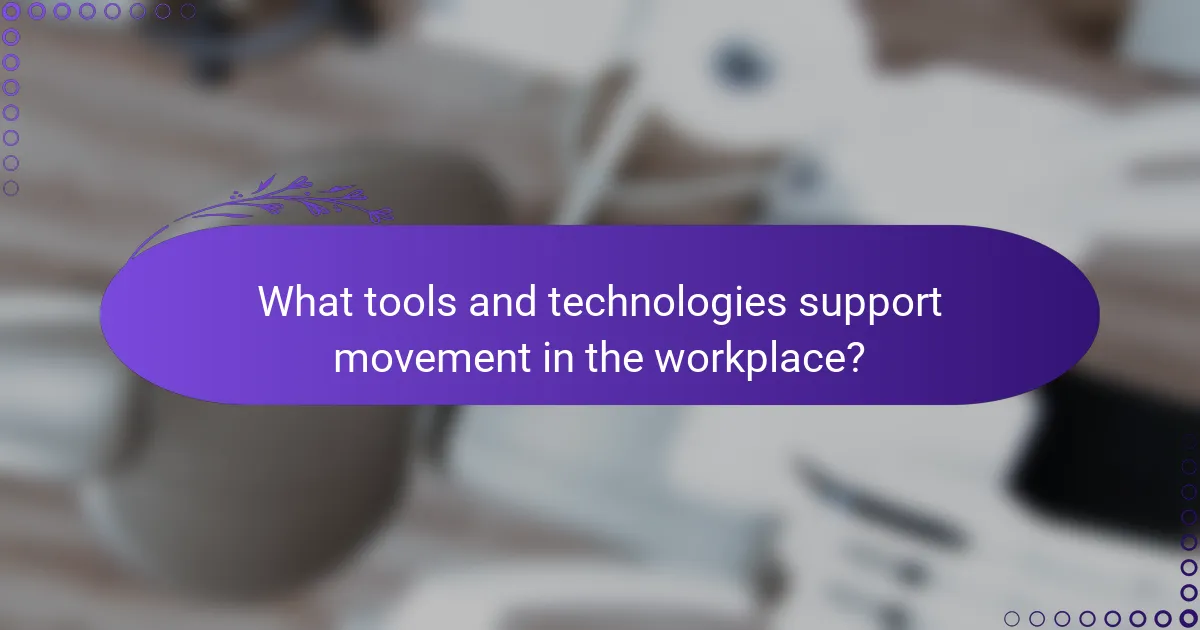
What tools and technologies support movement in the workplace?
Various tools and technologies can enhance movement in the workplace, promoting productivity and well-being. These include ergonomic furniture, fitness apps, and activity tracking devices that encourage employees to stay active throughout the workday.
Ergonomic furniture
Ergonomic furniture, such as sit-stand desks and adjustable chairs, supports movement by allowing employees to change their posture easily. This flexibility can help reduce discomfort and fatigue, leading to improved focus and productivity. Investing in quality ergonomic options can range from a few hundred to over a thousand dollars, depending on the features.
When selecting ergonomic furniture, consider the adjustability, material quality, and the specific needs of your workforce. Employees should be encouraged to alternate between sitting and standing every 30 to 60 minutes to maximize the benefits.
Fitness apps and wearables
Fitness apps and wearable devices can motivate employees to incorporate more movement into their daily routines. These tools often track steps, monitor heart rates, and provide reminders to take breaks or stretch. Popular options include apps like MyFitnessPal and devices like Fitbit, which can range from $50 to $300.
Encouraging team challenges through these apps can foster a culture of health and movement. Setting achievable goals, such as walking a certain number of steps per day, can enhance engagement and camaraderie among employees.
Activity tracking systems
Activity tracking systems, such as those integrated into office software or dedicated platforms, can help monitor movement levels within the workplace. These systems can provide insights into overall activity trends, allowing management to identify areas for improvement. Implementing such systems may involve initial setup costs but can lead to long-term benefits in employee health and productivity.
To effectively use activity tracking systems, ensure employees understand how to use the tools and the importance of regular movement. Regular feedback and recognition of active employees can further encourage participation and commitment to a more active workplace culture.


